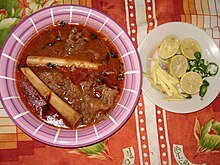Nihari
This article needs additional citations for verification. (August 2017) |
 | |
| Course | Breakfast, Lunch, Dinner |
|---|---|
| Place of origin | Indian subcontinent |
| Associated national cuisine | India, Bangladesh, Pakistan |
| Serving temperature | Hot |
| Main ingredients | Shank meat of beef, lamb and mutton, or goat meat, or Camel meat (mainly in Pakistan), also chicken |
| Other information | Served with bread (Naan) or rice |
Nihari (Bengali: নিহারী, Hindi: निहारी, Urdu: نہاری) is a stew from the Indian subcontinent consisting of slow-cooked meat, mainly shank meat of beef or lamb and mutton, goat meat and chicken, along with bone marrow. It is flavored with long pepper (pippali), a relative of black pepper.
Etymology[]
Nihari comes from the Persian nâhâr (ناهار) via Arabic nahâr (نهار), respectively meaning "lunch" and "daytime". It was originally eaten by Nawabs in the Mughal Empire as a breakfast item after their Islamic morning prayer of Fajr.[1]
History[]
According to many sources, Nihari originated in the late 18th century during the last throes of the Mughal Empire in the royal kitchens of Awadh, in modern-day Lucknow, Uttar Pradesh, India.[2] It was originally meant to be eaten as a breakfast dish, especially in cold mornings, on an empty stomach.[3]
Nihari developed with the overall cuisine of Muslims of the Indian subcontinent. It is an old popular delicacy in parts of Bangladesh, particularly Dhaka and Chittagong. People cooked it for one whole night and they ate it in the early morning at sunrise. The dish is known for its spiciness and taste. It was originally more of a delicacy with myriad variations on spiciness and texture.[4][5][better source needed]
Popularity[]
Nihari is a traditional dish of Muslims of Lucknow, Delhi, and Bhopal in India . After the Partition of India and creation of Pakistan in 1947, many Urdu speaking Muslims from northern India migrated to Karachi and Dhaka, and established restaurants. In Karachi, Nihari became a roaring success[6] and soon was found all over Pakistan. Now Nihari is available in Pakistani restaurants around the world. A particular favorite is nalli nihari, which is made with marrow added to nihari, and makes the stew very rich.

In some restaurants, a few kilos from each day's leftover Nihari is added to the next day's pot. This re-used portion of Nihari is called taar and is believed to provide the unique flavor. Some Nihari outlets in old Delhi boast of an unbroken taar going back more than a century.[7]
Medication[]
Nihari is also used as a home remedy for fever, rhinorrhea and the common cold.[8]
See also[]
References[]
- ^ Sengupta, Sushmita (3 January 2018). "Nihari: History Of The Meaty and Buttery Breakfast Staple of The Mughals". NDTV Food. Retrieved 3 January 2018.
- ^ "Nihari, a gift from Nawabs". The Times of India. Retrieved 5 March 2016.
- ^ "In celebration of winter's perfect dish, the mutton nihari!". Hindustan Times. 4 November 2017. Retrieved 30 January 2021.
- ^ "Nahari". Retrieved 5 March 2016.
- ^ "Nihari- historical recipe". Retrieved 23 December 2020.
- ^ "Nihari a la Mexican style". The Hindu Business Line. Retrieved 5 March 2016.
- ^ "Dilli Ka Dastarkhwan". Retrieved 28 November 2014.
- ^ "What is Nihari?". Archived from the original on 19 December 2014. Retrieved 28 November 2014.
- South Asian curries
- National dishes
- Muhajir cuisine
- Bangladeshi meat dishes
- Bangladeshi soups and stews
- Indian cuisine
- Pakistani soups and stews
- Pakistani meat dishes
- Hyderabadi cuisine
- Lahori cuisine
- Mughlai cuisine
- Telangana cuisine



